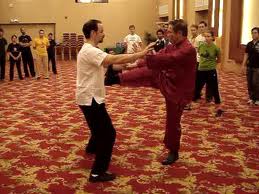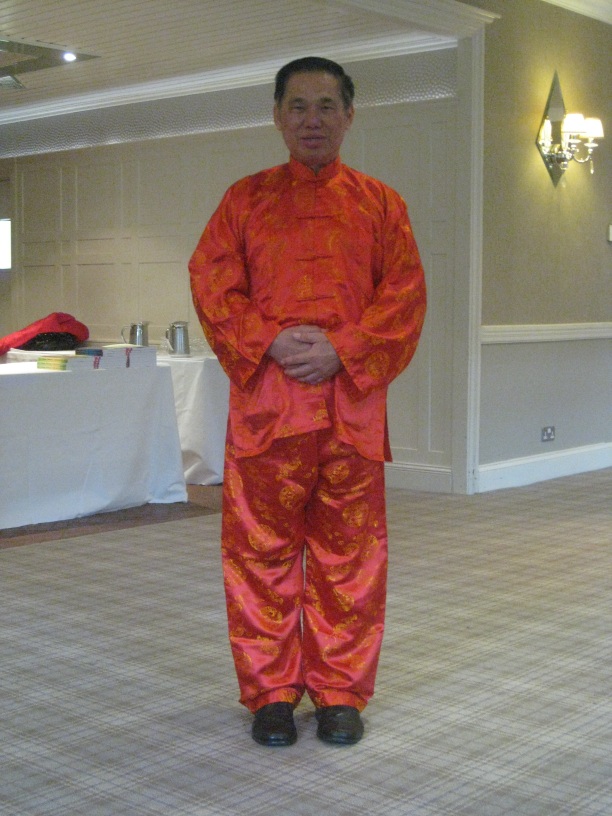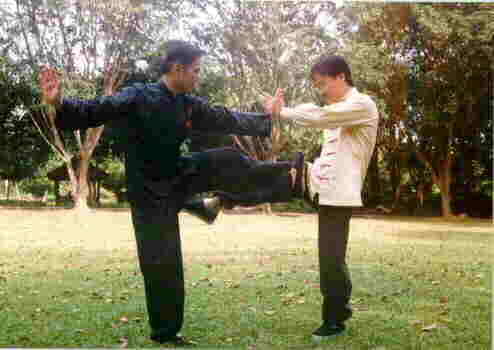SELECTION OF QUESTIONS AND ANSWERS
MARCH 2014 PART 2

Wing Choon Kungfu
Question 1
I would like to ask you how is the breathing done in Shaolin Wahnam
- Breathing in and out through the nose?
- Breathing in through the nose and out partially through the nose and partially through the mouth?
- Is natural breathing done through the nose?
- Isn't breathing in through the nose and out through the mouth a provoked breathing method, done for more external purposes?
- Is it safe to say that this method is used in hard moving qigong?
And, of course, how do you suggest proper breathing should be done.
— Alberto, USA
Answer
Many people think of breathing as just breathing in and out. But in chi kung, breathing is very sophisticated. Your specific questions are answered below.
>> Breathing in and out through the nose?
We use this method for specific situations, like when we want to slow down the breathing process.
>> Breathing in through the nose and out partially through the nose and partially through the mouth?
We may sometimes do this, but usually we breathe in through the nose and out through the mouth.
>> Is natural breathing done through the nose?
Natural breathing is breathing in though the nose and breathing out through the mouth. This is what babies do. But it is not breathing in and out through the nose only.
>> Isn't breathing in through the nose and out through the mouth a provoked breathing method, done for more external purposes?
No, it is not a provoked method, it is the natural method, which means if one does not consciously interfere with his breathing, he will breathe in through his nose and breathe out through his mouth.
In special situations he may modify his breathing. For example, when he is swimming, in order water does not get into his lungs, he breathes in and out through his mouth. When he is out of water, he goes back to his natural breathing of in through the nose and out through the mouth.
If he wants his breathing to slow down or to be gentle, like in meditation, he breathes in and out through his nose. When he goes out of meditation he returns to his natural breathing of in through his nose and out through his moith.
>> Is it safe to say that this method is used in hard moving qigong?
The breathing method in hard qigong looks like natural breathing but is not the same. In natural breathing, one breathes in gently through the nose and breathes out gently through the mouth. There is no pause in between breathing in and out. The breathing is natural, that is he is usually not aware of his breathing process.
When practicing hard qigong, a practitioner consciously breathes in through his nose, more forcefully than in normal breathing but not in a forced manner, gently and consciously breathes out forcefully but not in a forced manner through his mouth with his mouth wide open often with an explosive sound. Sometimes he may breathe out three times for each time he breathes in. Depending on the type of hard qigong, he may pause for a while, which may be quite long sometimes, in between his breathing in and breathing out. Sometimes there is no need for pause.
>> And, of course, how do you suggest proper breathing should be done.
Proper breathing is natural breathing, that is breathing in through the nose gently and breathing out through the mouth gently without being conscious of the breathing.
Breathing has a direct impact on our force, stamina and mental performance. We in Shaolin Wahnam pay great importance to breathing methods, using the best method for a particular purpose. We have more than a dozen breathing methods. The following are a few examples.
- In - pause - out - pause, as in performing "Lifting the Sky".
- In - out, as in performing "Pushing Mountain".
- In - out - out - out, as in performing "Shooting Arrows".
- In - hold - hold - hold - out, as in "Nourishing Kidneys".
- In - in - in - out - out - out - out - out - out - out, as in "Thousand Steps".
- Explode - swallow - in, as in "Black Tiger Steals Heart".
- In - flow - explode - swallow, as in "Single Whip".
- Flow - explode - swallow - in, as in "Green Dragon".
- In - flow - flow - flow - explode - swallow, as in Pressing Attack.
- In - flow - out - flow, as in Small Universe
- Neither in nor out, as in Cosmic Breathing.
Question 2
I'm your fan. I'm doing your exercises. This year I hope to have lessons with you.
— Alessandra, Brazil
Answer
Although one can get many benefits by learning from my books, webpages or videos, the benefits are much more, in quantity as well as quality, if he (or she) learns personally from me or from our certified instructors. The difference is quite unbelievable. Hence, I am glad you have decided to learn from me personally.
I would recommend that you attend my intensive course in Malaysia in chi kung, Shaolin Kungfu or Taijiquan depending on your interest. If this is not feasible you can attend any of my regional courses in many parts of the world.

Abdominal Breathing
Question 3
Can you through your mind get your own thoughts to another person to influence him?
Answer
Not only I but many of our instructors and some of our advanced students can use our mind to influence other people. But we consider this unethical and we do not do it, unless the case is clearly ethical and beneficial to all involved.
Here are some examples.
In a course I ask students to perform an exercise on their own to ascertain that they can practice competently at home. When some students take too long a time to complete, while their classmates, having completed the exercise, are waiting in their seats, I send a thought for them to complete the exercise and they do so immediately. This is ethical and beneficial to all involved.
When an advanced student comes to my special course and lands at an airport, and the immigration officer takes a long time to examine his passport, which is in order, he just sends a thought to the officer to ask him to stamp the passport and completes the entry process speedily. The officer will just do so. This is ethical and beneficial to all.
Suppose we are salespersons and want to sell a product to a perspective customer. We can use our mind to influence the customer buy the product. But we won't do this as we consider it unethical. The sale is good for us but it may or may not be good for the customer. Even when we think the purchase is good for him, we would let him make his own choice.
We are ethical because we believe it is the right thing to do. It is worthwhile to point out, that for the sake of discussion even when one were to leave out ethics and righteousness and consider only self-interest, it is still to the interest of a salesperson not to employ his mind power, if he has it, to influence a customer to buy a product he does not want. The dis-satisfied customer, for example, would cause complaints that would drain the energy and time of the salesperson which he could better use for other sales.
Question 4
I have been experiencing very strange sensations and phenomena. I don't know what to do about them and am afraid to carry on with practice.
Recently my dan tian started to produce a lot of heat/fire that has been spreading out. I have been only practicing Lifting the Sky, Pushing Mountains and chi flow. For these past few days when I breathed in I felt a lot of heat in my chest which moved to the dan tian upon exhaling.
— Ausar, England
Answer
You need not worry. You are doing fine. Nevertheless, it is good that you stop practicing for a few days to slow down your rapid progress.
As I told you before, you were a kungfu master in one of your past lives. The training you receive from our school triggers off the force and ability you already had.
The problem or privilege we face -- depending on one's perspective -- is that we have become so skillful that we can have tremendous force or advanced results with any techniques we use.
Relatively, Lifting the Sky, Pushing Mountain and chi flow are low level techniques, compared with, for example, Sinew Metamprphosis and consolidating energy.
For other people who have the opportunity to practice genuine, albeit low-level, chi kung, performing Lifting the Sky or Pushing Mountain will generate a gentle chi flow. This will make them fresh and give them some sense of well being. If they have some health problems, conscientiously practicing Lifting the Sky or Pushing Mountain followed by chi flow will eventually overcome their health problems.
But for us we can use Lifting the Sky or Pushing Mountain to produce advanced results. In our courses, especially the intensive courses in Malaysia, I have to remind our students to purposely lower their standard of practice so as not to over-train.

Pushing Mountain
Question 5
However two days ago the feeling escalated. After pushing mountains when I sent chi down to my dantien I felt like it started moving/breathing on its own accord. When it inflated I felt a lot of heat rush in. I just let it happen.
Then I started feeling like white/hot liquid moving in streams/pathways of energy around my right chest area and around my back opposite the dantien (I think around the ming men). Sometimes I feel the hot liquid energy right at the center of my chest moving slowly downward. Then I started feeling these streams of energy trickle in pathways down and up my legs and arms. My bai hui was also pulsating fast, then I could feel my heartbeat increase.
After then I've been feeling these hot/liquid energy's moving around my body (slowly up the spine, torso, down the legs, up and down the ribcages, chest). My dantien is still hot. Actually during one session I actually felt there was a watery, gooey, ball of energy at the qihai point. The feeling of the liquid energy (some of it is hot, some just feels watery) moving around my body is not unpleasant, but I don't know if it's a problem. I would much prefer if I could bring it back to dan tian somehow. I am going take a break from practice until all these feelings stop.
Answer
These are results of masters who have practiced for 20 or more years.
It is wise of you to take a break. Everything will be fine.
Question 6
Are roundhouse kicks, hooks and all such following free attacks found in traditional kung fu as well?
— Kshitij, India
Answer
Some of these attacks are not found in some styles of kungfu. It is not because the kungfu practitioners do not know them, but because these techniques contain innate weaknesses that make their application in combat disadvantageous.
But if opponents use these attacks on the kungfu practitioners, the kungfu practitioners can counter them effectively.
Roundhouse kicks, for example, are not found in Wing Choon Kungfu. But if an opponent were to execute roundhouse kicks on a Wing Choon practitioner, the attacker will be in serious trouble. There are many typical Wing Choon counters against roundhouse kicks.
The practitioner who practices Wing Choon Kungfu, which was invented by an elegant, graceful lady, would not block the roundhouse kicks. But as soon as the attacker kicks, he will find his knee being fractured, his groin being hit, this throat being pierced, or his head being struck from behind.
But all attack and defence techniques in all martial arts, including shoots, take-downs, pin-downs, grabbling, sophisticated locks and throws, are found in Shaolin Kungfu.
Editorial Note: Kshitij 's earlier questions can be found at March 2014 Part 1 issue of the Question-Answer Series.

A thrust kick against a round-house kick
Question 7
Because it is a basic for every art, and I have read about Shaolin san shou where the san shou is called sanda after it is made a sports version but the original sanshou came after studying techniques from Bagua, Taichi, Drunken Boxing, Praying Mantis, Xingyi, Choy Li Fut, Hoong Kuen, Tiger, Monkey etc. I'm sure every style has these hooks, roundhouse kick, etc. types of free techniques.
Answer
San-shou and san-da are not modern inventions. They have been in traditional kungfu for centuries.
Technically san-shou and san-da are different, though some people use the two terms interchangeably.
San-shou means miscellaneous techniques. It refers to using specific counters against specific attacks. If a Muay Thai fighter executes a powerful right sweeping kick at your left ribs, for example, if you practice Monkey Style Kungfu, you will move diagonally forward to your right, squat down and grip your opponent's groin with your left monkey paw using the pattern "Monkey Steals Peach".
If you practice Taijiquan, you will probably use a different counter against the same attack. You step diagonally to your right and kick your opponent's groin with a left thrust kick using the pattern "Cross-Hand Thrust-Kick".
Hence, "Monkey Steals Peach" is a Monkey Style Kungfu san-shou, and "Cross-Hand Thrust-Kick" is a Taijiquan san-shou against a Muay Thai sweeping kick. In either case the kungfu exponent disables the Muay thai fighter as soon as he attacks. And you don't need to make your legs hard to do so.
San-da means miscellaneous fighting or free sparring. In other words, you do not follow a routine as you fight. The attacks come at random. In the past those who practiced Monkey Style Kungfu, naturally would use Monkey Style Kungfu for san-da or free sparring. Those who practiced Taijiquan would use Taijiquan for free sparring. One would use the style of kungfu or martial art he had been trained in for free sparring. But today regardless of what kungfu style they practice, most practitioners use kick-boxing.
Question 8
And can you tell me certain things about the Shaolin heroes who fought in combat, especially Shaolin monks like San Te, Sam Tak, Ji Sin, etc. and also about Shaolin rebels like Tong Chen Jin, Hu Hui Chien, Hung Hsi Kuan, Fong Si Yu, Hung Man Ting, Wong Fei Hung.
Were they kung fu masters or even kung fu boxers, i.e. did they ever use free fighting techniques as well? Not only kung fu but at certain time they might have used free fighting techniques like hooks or straight punches or front kicks or roundhouse kicks along with kung fu techniques as well, right?
Answer
San Te is the Mandarin pronunciation of Sam Tak, which is in Cantonese. The two names refer to the same person, the second most senior disciple of Ji Seen, the abbot of the southern Shaolin Temple on the Nine Lotus Mountain in Fujian Province of South China.
Tong Chen Jin, Hu Hui Thien, Hung Hei Kuan and Fong Si Yu were disciples of Ji Seen. Hung Man Ting was the son of Hung Hei Kuan. Wong Fei Hung, a well known Shaolin master, was three generations later.
All of them were great Shaolin fighters. They used Shaolin techniques in their fighting. It would be silly of them to use free fighting techniques. It would be like throwing away gems to use stones.
It is difficult for modern people to imagine their level of combat efficiency. It would be reasonable to say that modern world champions of any fighting styles would not last a minute with these masters in a real fight.
LINKS
Selected Reading
- What is Zen
- Green Dragon Speeds through Valley
- Lineage of Shaolin Wahnam
- A Question of Paradigm
- Simply Delicious
